The Interplay of Carbon and Cost in Infrastructure Projects
Operation and maintenance of infrastructure assets, particularly in nations like the UK, are major contributors to carbon emissions. Today, they contribute to 16% of total carbon emissions. This figure rises to 53% when the use of infrastructure is incorporated, a proportion that is expected to increase to over 90% in the coming decades.
These figures are not unique to the UK, they are mirrored internationally. This alarming trend underscores the critical need to address carbon emissions in infrastructure development, a sector often overlooked yet pivotal in combating the climate crisis.
World Economic Forum’s 2020 Global Risks Report: A Climate Alarm
Climate Risks at the Forefront — The 2020 Global Risks Report by the World Economic Forum, which surveyed 750 experts, placed climate-related risks as the top global concerns for the first time. This paradigm shift signals a growing recognition of the climate emergency and its impacts, emphasizing the need for immediate and decisive actions in sectors like infrastructure.
Overlooking the Carbon Cost in Construction
While the public is increasingly aware of the climate impact of various industries, the carbon emissions associated with infrastructure construction remain largely unaddressed.
This oversight is critical, as tackling these emissions is essential for achieving net zero targets and preventing drastic climate change.
Carbon Cost and the Economy
Reducing carbon emissions in infrastructure doesn’t just benefit the environment; it also makes economic sense. The concept of Carbon Cost Intensity (CCI) offers a novel way to evaluate the cost-effectiveness of carbon reduction measures in infrastructure projects. By measuring the cost per unit of reduced carbon, CCI provides a tangible metric for balancing environmental and financial considerations.
 Knowing that there is a relationship between carbon and cost is important, but to practically apply this knowledge requires a deeper level of understanding.
Knowing that there is a relationship between carbon and cost is important, but to practically apply this knowledge requires a deeper level of understanding.
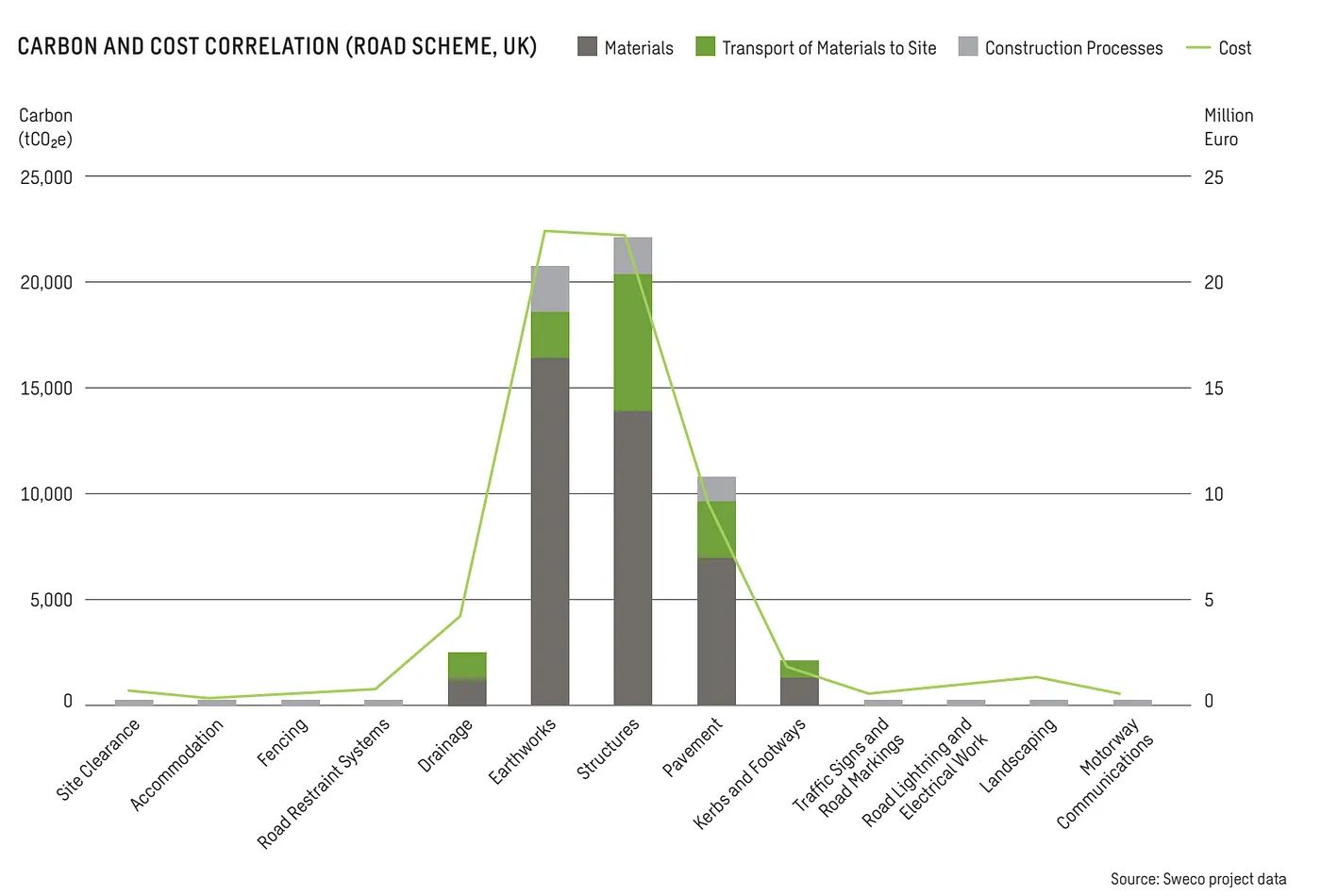
[Source: Sweco]
The Carbon Cost Tipping Point
Navigating the Complexity of Cost and Carbon: The ‘Carbon Cost Tipping Point’ represents a critical threshold in infrastructure projects, beyond which further carbon reduction leads to disproportionate cost increases. This concept challenges planners and engineers to think creatively about how to balance environmental goals with financial viability.
Beyond the Tipping Point: Innovation and Standards
The Role of Innovation: To surpass the limitations of the Carbon Cost Tipping Points, innovation in materials, design, and construction methods is essential. Updating standards and embracing new technologies are key to achieving sustainable infrastructure goals.
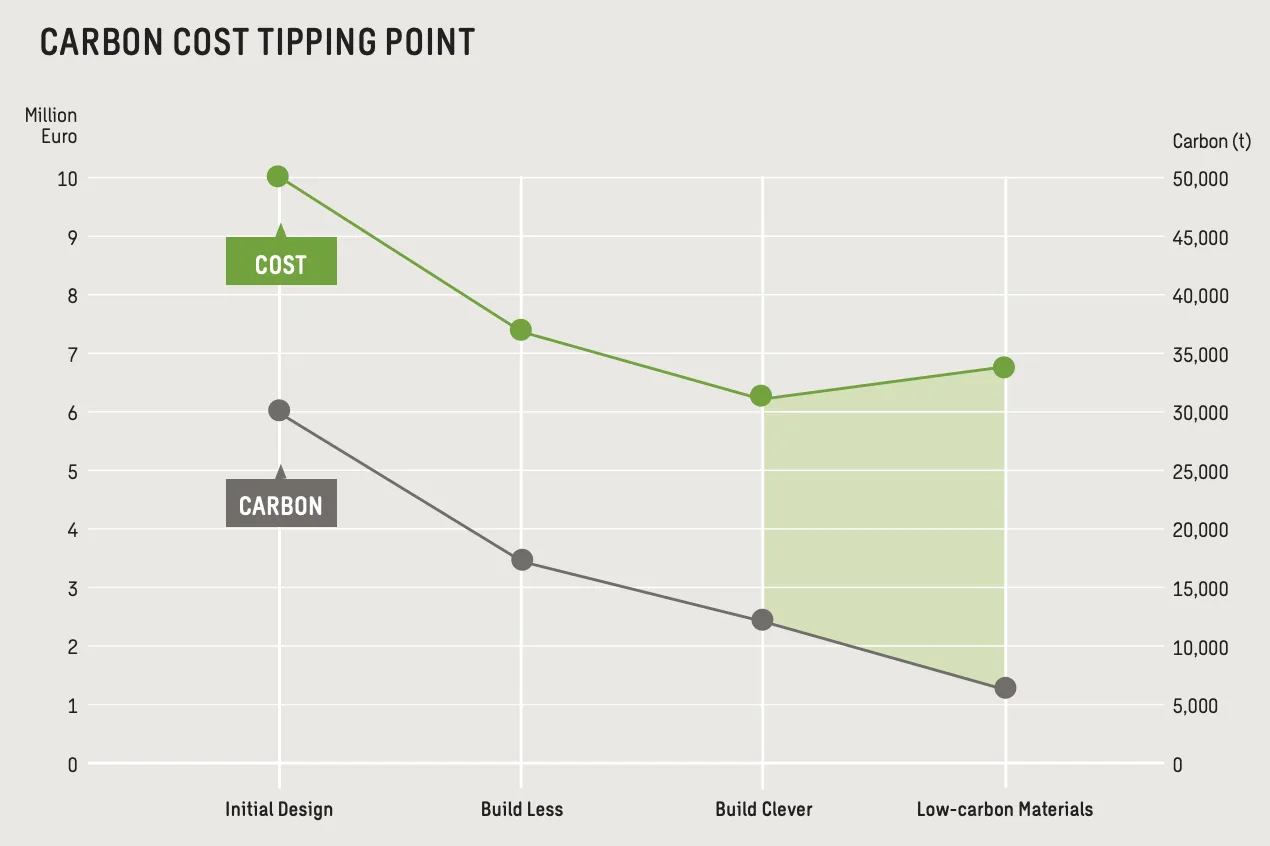
Carbon Cost Tipping Point [Source: Sweco]
Contractual Carbon Reduction and Policy
Enforcing Sustainability through Contracts and Policies: Embedding carbon reduction targets in project contracts and supporting them with robust government policies, such as carbon taxation, can significantly drive down infrastructure-related emissions. These contractual obligations ensure that sustainability is not just a goal but a requirement.
 To successfully address the climate crisis, we must make carbon reduction contractual, not just coincidental.
To successfully address the climate crisis, we must make carbon reduction contractual, not just coincidental.
A Case Study of Contractual Carbon Management from Sweden
The Swedish Transport Administration, Trafikverket, in response to Sweden’s net zero goals, established a target for infrastructure carbon neutrality by 2045. From 2016, for projects over €5 million, they mandated contractual climate requirements including carbon reduction targets. Trafikverket offers financial incentives for surpassing these targets and requires the use of their carbon tool, Klimatkalkyl, for consistent carbon calculation across projects. This approach has led to significant carbon reduction and encouraged innovative solutions in infrastructure design, moving beyond traditional methods.
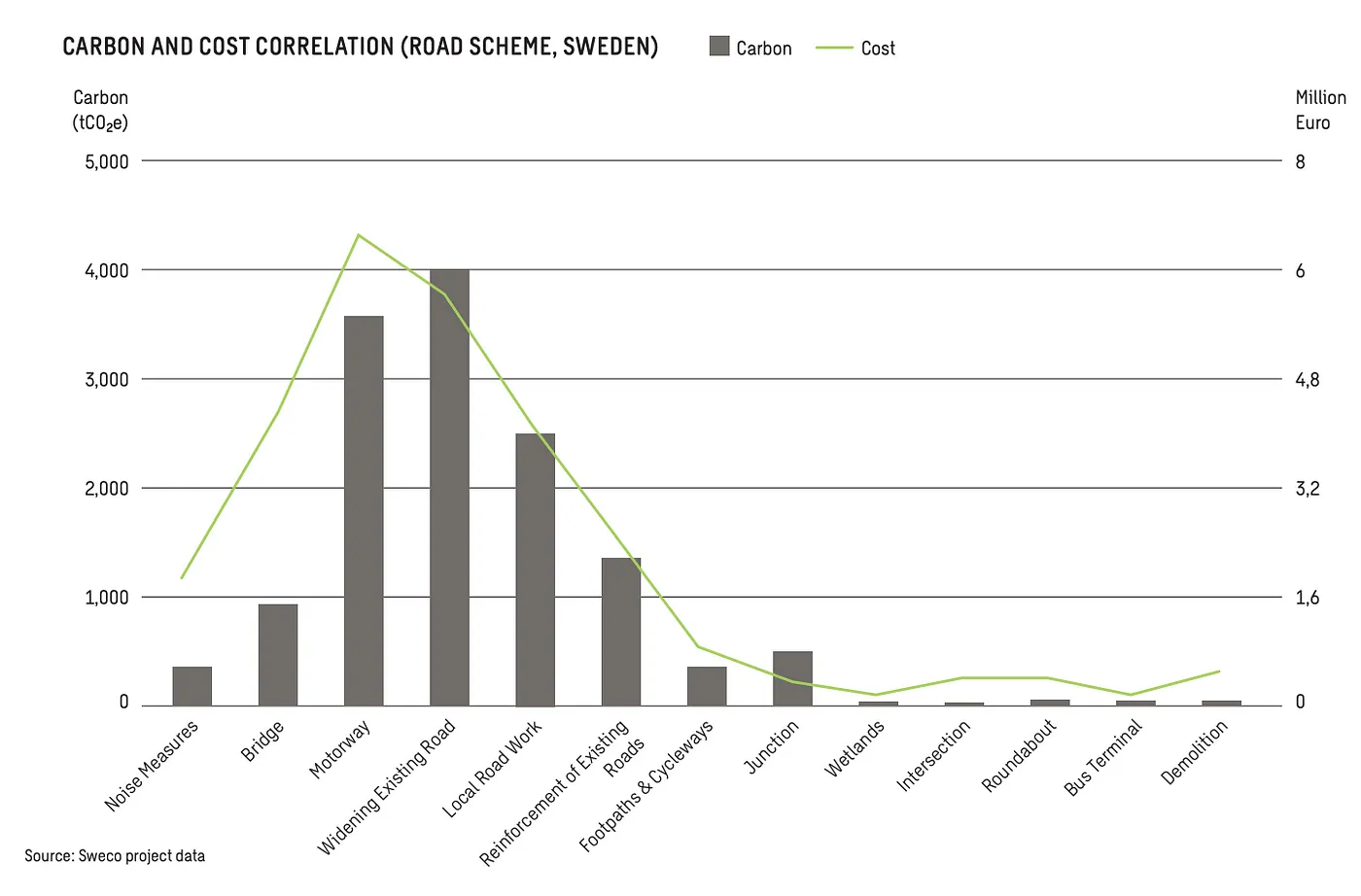
Carbon cost tipping points exist beyond which carbon reduction actually increases cost. [Source: Sweco]
Carbon Cost Management in Practice
Case Studies of Success: Several infrastructure projects have demonstrated how effective carbon cost management can lead to successful outcomes. These case studies showcase the benefits and challenges of implementing carbon reduction strategies.

[Source: Sweco]
Marginal Abatement Cost Curves in Infrastructure projects
Marginal Abatement Cost Curves (MACCs) can be effectively utilized in infrastructure carbon and cost management to provide a clear visualization of carbon emissions abatement options. These curves order various mitigation measures by their economic cost of emissions abatement, offering an easy comparison across different sectors. MACCs help in identifying where abatement opportunities are the largest and most cost-effective, serving as a starting point for deeper discussions and analysis on carbon reduction strategies. They are instrumental in framing carbon reduction options and guiding policy decisions by highlighting the most economically viable measures.
However, it’s important to recognize their limitations, such as not capturing non-market barriers, limited treatment of uncertainties, and difficulty in addressing dimensions other than direct costs. For effective use, understanding and embracing these complexities is crucial.

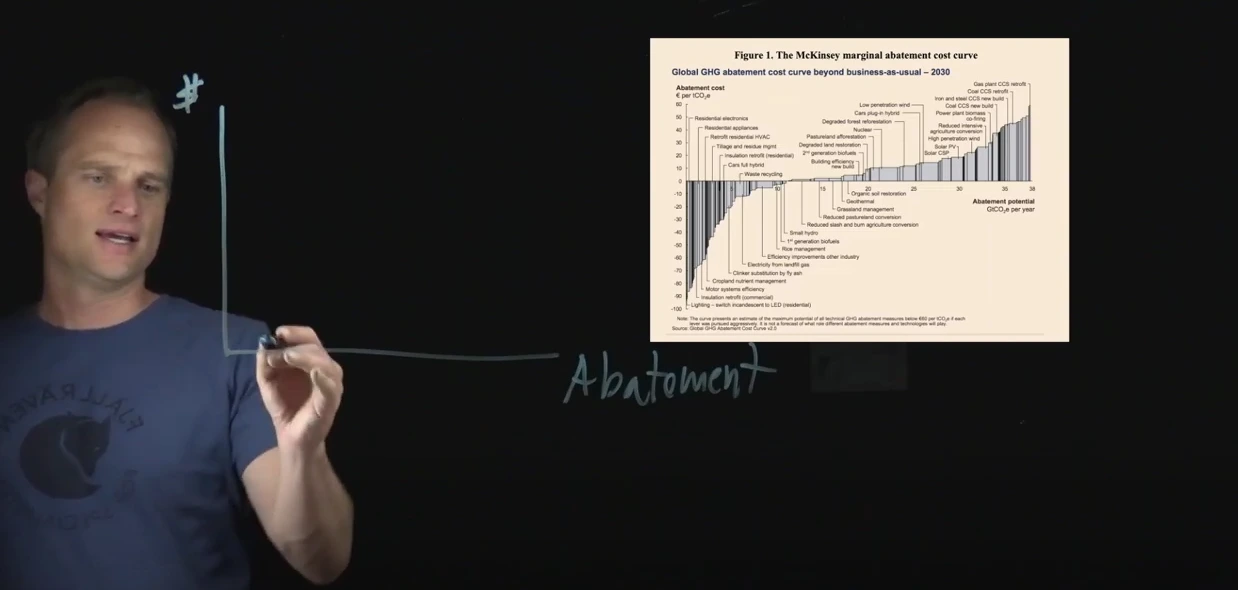
The Future of Sustainable Infrastructure
The future of infrastructure is inherently linked to sustainability. Advances in technology and policy will continue to shape how we approach carbon cost management, with a growing emphasis on integrating sustainable practices throughout the project lifecycle.
A call to action
The insights from these reports make one thing clear: managing carbon emissions in infrastructure is not just an environmental imperative but an economic necessity. It’s time for industry leaders and policymakers to prioritize carbon cost management, ensuring a sustainable future for all.
How 2050 Materials can help
2050 Materials supports organizations to embed critical carbon and sustainability data related to the materials which go into these infrastructure projects.
Whether through a digital platform or by integrating our API, several organizations are making leaps in delivering more climate-aligned infrastucture for our cities.
Dive deeper into case studies we’ve worked on and reach out to see how we can help.
References & Sources
- Sweco — Carbon Cost in Infrastructure: the Key to the Climate Crisis?
- Climate Mobilization Project (2020) Global Climate Emergency Declarations. Available at: https://www.theclimatemobilization.org/climate-emergency-overview.
- IPCC, 2018: Summary for Policymakers. In: Global Warming of 1.5°C.
- European Commission, A European Green Deal — Striving to be the first climate-neutral continent. Available at: https://ec.europa.eu/info/strategy/priorities-2019-2024/european-green-deal_en.
- Committee on Climate Change (2019) Net Zero: The UK’s contribution to stopping global warming. Available at: https://www.theccc.org.uk/publication/net-zero-the-uks-contribution-to-stopping-global-warming/%0Awww.theccc.org.uk/ publications.
- European Commission (2018) Going climate-neutral by 2050. Available at: https://ec.europa.eu/clima/sites/clima/files/long_term_strategy_brochure_en.pdf.
- UK Government (2013) Infrastructure Carbon Review. Available at: https://www.gov.uk/government/uploads/system/uploads/attachment_data/file/260710/infrastructure_carbon_review_251113.pdf.
- Infrastructure Commission for Scotland (2020) ‘Phase 1: Key findings report — A blueprint for Scotland’.
- European Environment Agency (2018) Overview of electricity production and use in Europe. Available at: https://www.eea.europa.eu/data-and-maps/indicators/overview-of-the-electricity-production-2/assessment-4.
- Construction Climate Challenge (2019) Procurement Requirements for Carbon Reduction in Infrastructure Construction Projects.
- UK Green Building Council (2017) Delivering Low Carbon Infrastructure. Available at: http://www.ukgbc.org/sites/default/files/Delivering Low Carbon Infrastructure.pdf.
Related articles

The Most Interesting Low Carbon Products in Office Design
In this article and collection, we highlight 11 outstanding products that contribute to a lower carbon footprint in office design.
Read more
Top Low Carbon Building Boards: Performance, Benefits, and Use Cases
The building boards highlighted in this article and collection showcase low-carbon innovation in modern construction.
Read more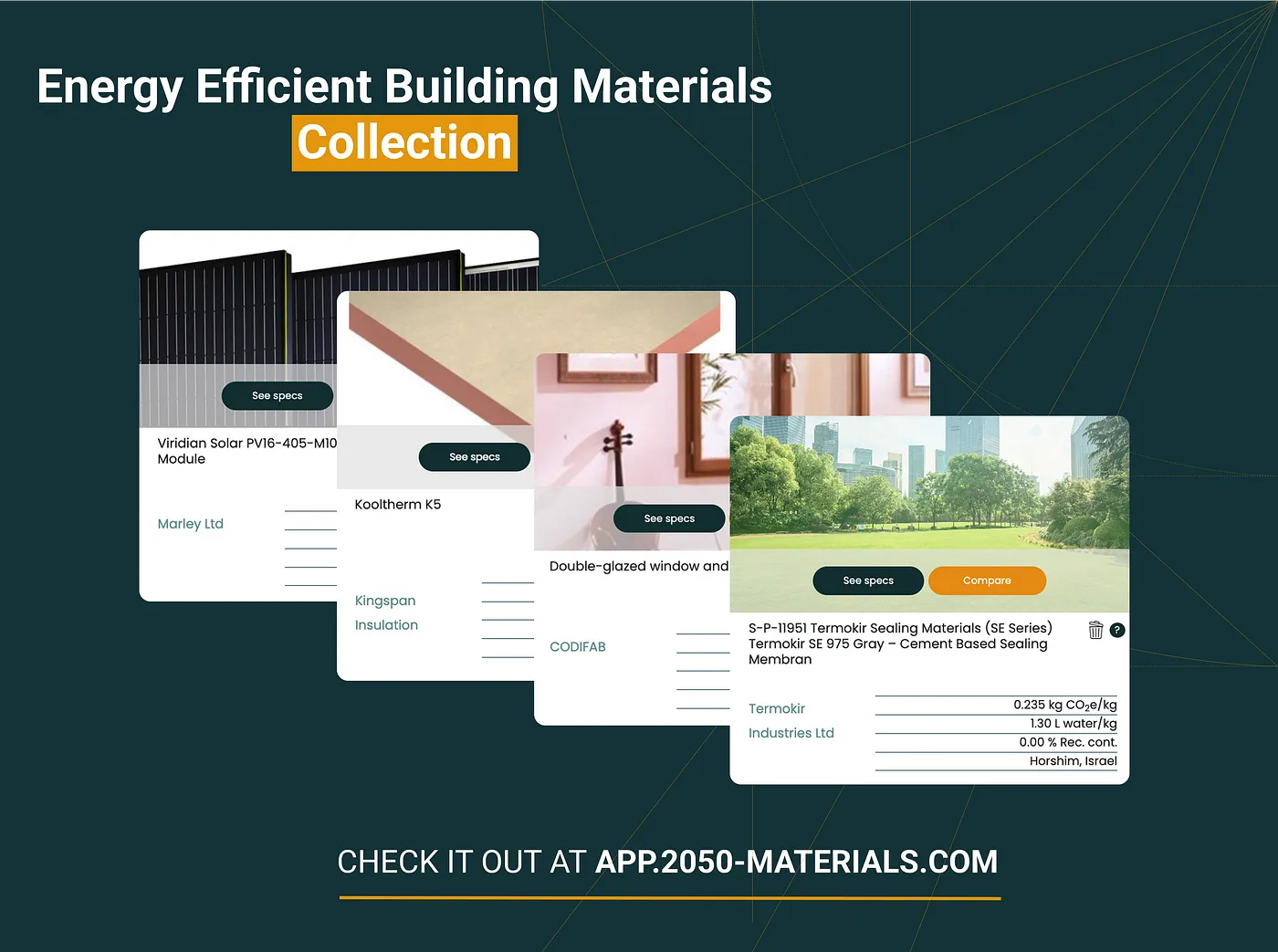
11 Interesting Energy Efficient Building Materials for Reduced Environmental Impact
Discover a collection of energy efficient building materials that not only reduce greenhouse gas emissions but also contribute to long-term durability.
Read more